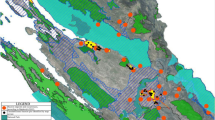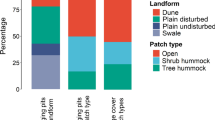Abstract
Vertical banks in mining sites can provide safe nesting sites for burrowing bird species. These burrows can then, in turn, provide nest sites for species unable to create burrows themselves, especially in areas where the abundance of safe nesting holes is a limiting factor. Thus, primary burrowing species can provide ecosystem services for secondary cavity-nesting species. Our objective was to study the availability of burrows of biotic origin in mining sites, and their role in improving colonization and local biodiversity of cliff-nesting birds (birds that rely primarily on rocky or sandy walls to breed). We selected the Sand Martin because it is a colonial ecological engineer species that nests frequently in mining sites. First, we estimated Sand Martin burrow abundance and occupation rates and identified secondary cavity-nesting birds in 8849 burrows from 30 colonies in ten mining sites in central Spain. Second, we studied the dynamics of the Sand Martin burrows, by estimating annual construction and disappearance rates. Finally, we studied factors that could favour secondary cavity-nesting bird occupation. We found that Sand Martins burrowed more than was previously estimated in mining sites, and that their burrows were used by five species of secondary cavity-nesting birds. The number of available burrows each year varied due to relatively high annual construction and disappearance rates. Numbers of Sand Martin pairs and burrows in the colonies were the main factors favouring secondary cavity occupation. Our results support promoting Sand Martins in mine restoration projects, not only to benefit this endangered bird, but also because their ecosystem services can benefit other cliff-nesting species of birds, thus increasing local biodiversity.
Zusammenfassung
Der Nutzen von Vögeln für die Renaturierung von Tagebauflächen: eine Fallstudie über den Höhlenbau der Uferschwalbe ( Riparia riparia )
Senkrechte Abbruchkanten in Tagebaugebieten können sichere Nistplätze für Erdhöhlenbrüter bieten. Diese Erdhöhlen können dann ihrerseits für solche Arten zu Nistmöglichkeiten werden, welche selber keine Höhlen graben können, speziell in Gebieten, in denen die Anzahl sicherer Bruthöhlen einen limitierenden Faktor darstellt. Daher können solche primären Erdhöhlenbrüter als „Ökosystemdienstleister“ für sekundäre Höhlenbrüter fungieren. Unser Ziel war es, die Verfügbarkeit von Höhlen biotischen Ursprungs auf Abbauflächen zu untersuchen und deren Bedeutung für die Förderung der Besiedlung und der lokalen Biodiversität an Steilwandbrütern (Vögel, die zum Nisten primär auf felsige oder sandige Steilwände angewiesen sind) zu beleuchten. Unsere Wahl fiel auf die Uferschwalbe, da diese ein Höhlen grabender Koloniebrüter ist, der häufig in Abbaugebieten brütet. Zunächst schätzten wir die Häufigkeit und die Nutzungsraten der Uferschwalben-Nisthöhlen und bestimmten die sekundären Höhlenbrüter in 8849 Bruthöhlen aus 30 Kolonien an zehn Abbaustellen in Zentralspanien. Anschließend untersuchten wir die Dynamik der Uferschwalben-Bruthöhlen, indem wir die jährlichen Raten von Bau und Verschwinden schätzten. Schließlich untersuchten wir noch die Faktoren, welche eine Besiedlung durch sekundäre Höhlenbrüter begünstigen könnten. Es stellte sich heraus, dass Uferschwalben stärker als zuvor angenommen Höhlen an Abbaustellen anlegten und dass ihre Höhlen von fünf Arten sekundärer Höhlenbrüter genutzt wurden. Die Anzahl verfügbarer Höhlen schwankte von Jahr zu Jahr, aufgrund relativ hoher jährlicher Bau- und Verlustraten. Die jeweilige Anzahl der Uferschwalbenpaare und –brutröhren in den Kolonien waren die Hauptfaktoren, welche eine sekundäre Höhlennutzung begünstigten. Unsere Ergebnisse unterstützen eine Förderung von Uferschwalben in Projekten zur Renaturierung von Tagebauflächen, nicht nur zum Nutzen dieser stark gefährdeten Vogelart, sondern auch, da andere Arten von deren Ökosystemdienstleistungen profitieren könnten und somit die lokale Biodiversität von Steilwandbrütern erhöht würde.

Similar content being viewed by others
References
Barton K (2017) MuMIn: multi-model inference. R package version 1.40.0. https://cran.r-project.org/web/packages/MuMIn/index.html. Accessed 16 Nov 2017
Bates D, Maechle M, Bolker B, Walker S (2015) Fitting linear mixed-effects models using lme4. J Stat Softw 67:1–48. https://doi.org/10.18637/jss.v067.i01
BirdLife International (2017) European birds of conservation concern: populations, trends and national responsibilities. Cambridge, UK. https://www.nabu.de/imperia/md/content/nabude/vogelschutz/170520-birds-of-conservation-concern-germany.pdf. Accessed 8 Mar 2018
Blancat J, Jurado P, Jiménez-moya F (1995) Contribución al conocimiento del abejaruco común Merops apiaster en la provincia de Sevilla. Orsis Org i Sist 10:99–104. ISSN 0213-4039. https://ddd.uab.cat/pub/orsis/02134039v10/02134039v10p99.pdf. Accessed 20 Nov 2017
Brambilla M, Rubolini D, Guidali F (2006) Factors affecting breeding habitat selection in a cliff-nesting peregrine Falco peregrinus population. J Ornithol 147:428–435
Brown CR, Brown MB (2001) Current ornithology, vol 16. Springer, Boston
Burke T (2017) Bank Swallow (Riparia riparia) breeding in aggregate pits and natural habitats. Dissertation, Trent University
Burnham KP, Anderson DR (2001) Model selection and multimodel inference A practical information-theoretic approach, 2nd edn. Springer, New York
Byers JE, Cuddington K, Jones CG et al (2006) Using ecosystem engineers to restore ecological systems. Trends Ecol Evol 21:493–500. https://doi.org/10.1016/j.tree.2006.06.002
Cano Sánchez J (2003) Gorrión Chillón (Petronia petronia). In: Martí R, Moral J (eds) Atlas de las aves reproductoras de España. Dirección General de Conservación de la Naturaleza-SEO, Madrid, pp 566–567
Casas-Crivillé A, Valera F (2005) The European Bee-eater (Merops apiaster) as an ecosystem engineer in arid environments. J Arid Environ 60:227–238. https://doi.org/10.1016/j.jaridenv.2004.03.012
Castillo I, Elorriaga J, Zuberogoitia I, Azkona A, Hidalgo S, Astorkia L, Iraeta A, Ruiz F (2008) Importancia de las canteras sobre las aves rupicolas y problems derivados de su gestión. Ardeola 55:103–110. http://globalraptors.org/grin/researchers/uploads/521/_ardeola55_castillo_2008.pdf. Accessed 11 Nov 2016
Chiquoine LP, Abella SR, Bowker MA (2016) Rapidly restoring biological soil crusts and ecosystem functions in a severely disturbed desert ecosystem. Ecol Appl 26(4):1260–1272. https://doi.org/10.1002/15-0973
Cockle KL, Martin K, Drever MC (2010) Supply of tree-holes limits nest density of cavity-nesting birds in primary and logged subtropical Atlantic forest. Biol Conserv 143:2851–2857. https://doi.org/10.1016/j.biocon.2010.08.002
Cordero Tapia P (1986) Aspectos de la ecoetología de la nidificación en el gorrión molinero [Passer m. montanus (L.)] y el gorrión común [Passer d. domesticus (L.)] en Cataluña. Dissertation, Universitat de Barcelona
Cramp S (1988) Handbook of the birds of Europe, the Middle East and North Africa. The birds of the Western Palearctic. Oxford University Press, UK
De Laet J, Summers-Smith JD (2007) The status of the urban House Sparrow Passer domesticus in north-western Europe: a review. J Ornithol 148(2):275–278
Donázar JA, Ceballos O, Fernández C (1989) Factors influencing the distribution and abundance of seven cliff-nesting raptors: a multivariate study. In: Meyburg BU, Chancellor RD (eds) Raptors in the modern world. WWGBP, Berlin, pp 45–552
Galvez Bravo L, Belliure J, Rebollo S (2009) European rabbits as ecosystem engineers: warrens increase lizard density and diversity. Biodivers Conserv 18:869–885. https://doi.org/10.1007/s10531-008-9438-9
García J, Álvarez E (2000) Expansión altitudinal del avión zapador Riparia riparia en la Cordillera Cantábrica. Ardeola 47(2):247–250. https://www.researchgate.net/profile/Javier_Garcia65/publication/272356747_expansion_altitudinal_del_avion_zapador_riparia_riparia_en_la_cordillera_cantabrica/links/54e30f850cf2966637984ba9/expansion-altitudinal-del-avion-zapador-riparia-riparia-en-la-cordillera-cantabrica.pdf?origin = publication_list. Accessed 28 Mar 2017
González S, Villarino A (1997) Nidotópica y situación actual del Avión Zapador Riparia riparia (L. 1758), en la Provinicia de Ourense (NO España). Ardeola 44:41–49. https://www.ardeola.org/es/volumenes/441/articulos/41-49/. Accessed 11 Mar 2017
Hansell MH (1993) The ecological impact of animal nests and burrows. Funct Ecol 7:5. https://doi.org/10.2307/2389861
Hjertaas DG (1984) Colony site selection in Bank Swallows. Dissertation, the University of Saskatchewan
Jones CG, Lawton JH, Shachak M (1994) Organisms as ecosystem engineers. Oikos 69:373–386. https://doi.org/10.2307/3545850
Kuhnen K (1985) Zur Paarbildung der Uferschwalbe (Riparia riparia). J Ornithol 126:1–13. https://doi.org/10.1007/BF01640439
Madroño A, González C, Atienza JC (2004) Libro Rojo de las Aves de España. Dirección General para la Biodiversidad-SEO/BirdLife, Madrid
Manning A, Wood J, Cunningham R, McIntyre S, Gordon I, Lindenmayer D (2011) Integrating research and restoration: the establishment of a long-term woodland experiment in south-eastern Australia. Aust Zool 35(3):633–648. https://doi.org/10.7882/AZ.2011.016
Mead CJ, Pepler (1975) Birds and other animals at Sand Martin colonies. Br Birds 68:89–99. https://britishbirds.co.uk/wp-content/uploads/article_files/V68/V68_N03/V68_N03_P089_099_A020.pdf. Accessed 8 Aug 2017
OMNRF (2017) Best management practices for the protection, creation and maintenance of Bank Swallow habitat in Ontario. Queen’s Printer for Ontario, Ontario, Canada https://www.ossga.com/multimedia/2017-03-27-100504-95129/bansbmpenpdffinalv.1.117mar17.pdf. Accessed 24 Oct 2017
Piotrowski S, Evans S, Walshe J (2011) Suffolk Tree sparrow Project 2008-2011. http://citeseerx.ist.psu.edu/viewdoc/download?doi=10.1.1.737.2559&rep=rep1&type=pdf. Accessed 23 Nov 2018
R Core Team (2017) R: a language and environment for statistical computing. R Foundation for Statistical Computing, Vienna
Rohrer Z, Rebollo S, Andivia E, Franco J, Rodríguez Urquía C (2019) Restoration and management for cliff-nesting birds in Mediterranean mining sites: the Sand Martin case study. Restor Ecol (under review)
Sekercioglu C (2006) Increasing awareness of avian ecological function. Trends Ecol Evol 21:464–471. https://doi.org/10.1016/j.tree.2006.05.007
Soler M (2014) Grajilla—Corvus monedula Linnaeus, 1758. In: Salvador A, Morales MB (eds) Enciclopedia virtual de los vertebrados españoles. Museo Nacional de Ciencias Naturales, Madrid
Spain (2007) Law 42/2007 of the 13th of December, of natural heritage and biodiversity. Boletín Oficial del Estado 299, 14 December 2007
Suvorov P, Kovář V, Heneberg P (2011) Využití nového hnízdního biotopu je asociováno se změnou ve frekvenci a druhovém složení smíšených kolonií břehule říční (Riparia riparia). Sylvia 47:49–66. http://oldcso.birdlife.cz/www.cso.cz/wpimages/video/sylvia47_4Suvorov.pdf. Accessed 8 Apr 2017
Wenny DG, DeVault TL, Johnson MD, Kelly D, Sekercioglu C, Tomback DF, Whelan CJ (2011) The need to quantify ecosystem services provided by birds. Auk 128:1–14. https://doi.org/10.1525/auk.2011.10248
Whelan CJ, Wenny DG, Marquis RJ (2008) Ecosystem services provided by birds. Ann N Y Acad Sci 1134:25–60. https://doi.org/10.1196/annals.1439.003
Wright DH, Lomeli H, Hofmann PS, Nguyen C (2011) Burrow occupancy and nesting phenology of Bank Swallows along the Sacramento river. Calif Fish Game 97(3):138–147. https://nrm.dfg.ca.gov/FileHandler.ashx?DocumentID=46494. Accessed 9 Mar 2017
Acknowledgements
This project was financed through a partnership between the International Foundation for the Restoration of Ecosystems and LafargeHolcim Spain, and was supported by the Forest Ecology and Restoration Group of the University of Alcalá. E. Andivia was supported by a postdoctoral grant funded by the Universidad Complutense de Madrid. We would like to specially acknowledge Pilar Gegúndez and Raúl Pérez for their support, and Manuel Andrés, Rafael Barrientos and Aurelio Malo for their contributions to this study. We declare that this work fully complied with current Spanish laws.
Author information
Authors and Affiliations
Contributions
S. R. and Z. R. conceived and designed the research; Z. R., J. F. and C. R. U. collected the data and S. R. assisted in this; E. A. and Z. R. performed the statistical analyses; Z. R. wrote the first draft of this article; Z. R., S. R. and E. A. wrote and edited the final manuscript.
Corresponding author
Ethics declarations
Ethical statement
All applicable international, national and/or institutional guidelines for the care and use of animals were followed. All procedures involving animals were in accordance with the ethical standards of the Spanish Ministry of Agriculture, Environment and Food and the Dirección General del Medio Ambiente de la Consejería de Medio Ambiente, Administración Local y Ordenación del Territorio de la Comunidad de Madrid (REF:10/148281.9/17, date 18 May 2017). Bird manipulation was done by an expert of SEO/BirdLife’s Bird Migration Center and with authorization for scientific banding from the Spanish Ministry of Agriculture, Environment and Food (permit no. 530339).
Additional information
Communicated by T. Gottschalk.
Publisher's Note
Springer Nature remains neutral with regard to jurisdictional claims in published maps and institutional affiliations.
Electronic supplementary material
Below is the link to the electronic supplementary material.
Rights and permissions
About this article
Cite this article
Rohrer, Z., Rebollo, S., Andivia, E. et al. Bird services applicable to mine restoration: a case study of Sand Martin (Riparia riparia) burrow construction. J Ornithol 161, 243–255 (2020). https://doi.org/10.1007/s10336-019-01711-5
Received:
Revised:
Accepted:
Published:
Issue Date:
DOI: https://doi.org/10.1007/s10336-019-01711-5




